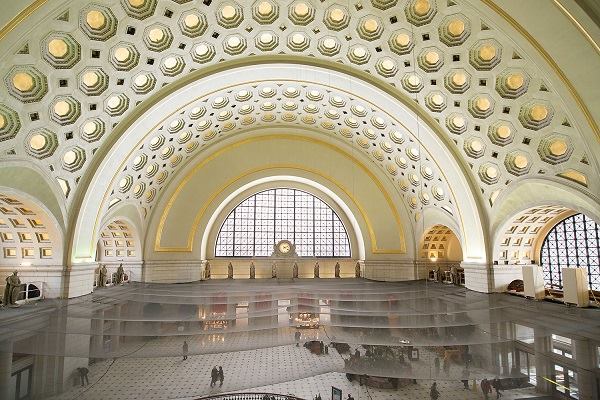
Behind the Scenes: Restoring Union Station
An earthquake damaged Washington, D.C.’s world-famous train station in 2011. ARCHITECT toured the ongoing work to restore this American masterpiece.

Inside Union Station, the gateway to the nation’s capital, scaffolding rises nine stories into the air. There, on the fourth and final staging level inside the train station, workers restore the ceiling of the Beaux-Arts masterpiece, designed by architect Daniel Burnham for Washington, D.C., in 1907. Architects and preservationists call this level the “dance floor.”
At 90 feet up, close enough to touch the barrel-vaulted ceiling, Union Station shows its age. A 5.8-magnitude earthquake near Mineral, Va., in 2011 added fractures along the ceiling inside the station’s Main Hall and concourse. Those cracks extended to the 255 octagonal coffers as well as the more than 350 diamond and triangular coffers along the Main Hall’s ceiling. Upon close inspection, the gold-leaf gilding at the center of those coffers—a signature of Union Station—appeared to be flaking, peeling, and tarnishing.


Truth be told, though, not all those cracks and blemishes are the fault of the earthquake. Union Station Redevelopment Corporation (USRC) president Beverley Swaim-Staley likens the capital’s central train station to a stadium used by 100,000 people every day: a building that sees its share of wear and tear. “Twenty-five years into it, we were ready for a repaint,” says USRC project manager Tom Whitaker—referring to the last renovation for Union Station.
“It needs to be repaired every generation. Every 25 or 35 years,” says John Bowie, AIA, the architect overseeing the renovation. So this work was coming no matter what.

Over an approximately three-year span, construction workers will repair the cracks along the five bays that make up Union Station’s Main Hall. Work on Bay 1 began in May 2013 and took approximately 8 months. Construction is under way on Bay 2 (where the majority of the photographs shown in this story were taken); Bowie says that the team will likely move to Bay 3 sometime in June.
“I can’t even predict the way we’ll do Bay 3,” he says. His team is documenting every step of the process, and it made significant changes between work on Bay 1 and Bay 2. “The building is just loaded with unexpected conditions.”


One of the most exciting aspects of the project is the re-gilding of several hundred coffers along the Main Hall. The project will see more than 120,000 sheets of delicate, 23-karat gold leaf applied to the coffers. Craftsmen from the Olney, Md.–based Gilder’s Studio apply the leaf one 4-by-4-inch sheet at a time. (At the same time, specialists from the Baltimore-based company Hayles and Howe are also installing anchors to permanently secure each coffer’s decorative, plaster egg-and-dart molding and corner cornice leaves to the ceiling.)

Bowie says that gold-foil samples were sent to a laboratory in Chicago to be analyzed. Metallurgists there determined that by replacing the existing 22-karat gold leaf (much of which was added during the last restoration) with 23-karat gold leaf, the lifespan of the gilding can be boosted from about 35 years to more than 75 years. Giusto Manetti Battiloro, a workshop in Florence, Italy, is producing all the gold for the project. (Corporate sponsor American Express picked up half the $700,000 for producing the gold alone.)


The near-ceiling access offers a perspective on Union Station that can’t be had any place else. The triangular coffers, for example, were designed to be popped out whenever Union Station authorities wanted to hang things from the ceiling; metal cables could then be run across the ceiling span between triangular-coffer holds to hoist U.S. flags or “Buy War Bonds” pennants.
But the significance of this project is plain from the ground, too. “[New York] made the decision not to preserve an historic resource,” says Robert Nieweg, field director for the National Trust for Historic Preservation—referring, of course, to Penn Station. “The unique experience of visiting the nation’s capital depends upon the preservation of this space.”




